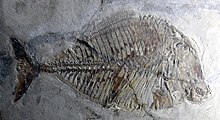The Tuscahoma Formation or Tuscahoma Sand is a geologic formation in Mississippi and Alabama , USA. It preserves fossils dating back to the early Paleogene period , from the Late Paleocene and Early Eocene .[ 1] Wasatchian -aged locality near Meridian, Mississippi was deposited in an estuarine habitat that preserves a significant terrestrial vertebrate fauna, known as the "Red Hot local fauna".[ 2] [ 3] Willwood Formation of Wyoming.[ 3] [ 4]
Vertebrate paleofauna
Cartilaginous fishes
Based on the Paleobiology Database:[ 5]
Ray-finned fishes
Based on the Paleobiology Database:[ 6]
Reptiles
Based on the Paleobiology Database:[ 4] [ 5]
Mammals
The Tuscahoma Formation preserves a diversity of earliest Eocene-aged mammals. Almost all mammals are known only from isolated teeth. There appear to be significant differences in the faunal composition between the Tuscahoma Formation and the contemporaneous Bighorn Basin of the western US, indicating some level of provincialism in North American mammal species assemblages of the time. The formation appears to have been biased against the preservation of large-sized mammals, meaning that the majority of mammal remains from the formation are of smaller taxa.[ 3]
Based on the Paleobiology Database and Dawson & Beard (2009):[ 4] [ 3]
Cimolesta
Macroscelidea
Macroscelideans of the Tuscahoma Formation
Genus
Species
Location
Stratigraphic position
Material
Notes
Images
Haplomylus H. meridionalis
Meridian, Mississippi
Early Eocene
An apheliscid .
Ungulates
Pan-Carnivorans
Eulipotyphlans
Apatotherians
Apatotherians of the Tuscahoma Formation
Genus
Species
Location
Stratigraphic position
Material
Notes
Images
Apatemys A. pygmaeus
Meridian, Mississippi
Early Eocene
An apatemyid . Type locality of species.
Rodents
Primates
Primates of the Tuscahoma Formation
Genus
Species
Location
Stratigraphic position
Material
Notes
Images
Choctawius C. foxi
Meridian, Mississippi
An omomyid . Type locality of genus and species.
Teilhardina T. magnoliana
An omomyid.
See also
References
^ "Geolex — Tuscahoma publications" . ngmdb.usgs.gov . Retrieved 2024-11-21 .^ "PBDB Collection" . paleobiodb.org . Retrieved 2024-11-21 .^ a b c d Beard, K. Christopher; Dawson, Mary R. (2009). "Early Wasatchian Mammals of the Red Hot Local Fauna, Uppermost Tuscahoma Formation, Lauderdale County, Mississippi" . Annals of Carnegie Museum . 78 (3): 193– 243. doi :10.2992/007.078.0301 . ISSN 0097-4463 . ^ a b c "PBDB Collection" . paleobiodb.org . Retrieved 2024-12-10 .^ a b "PBDB Collection" . paleobiodb.org . Retrieved 2024-12-10 .^ "PBDB Collection" . paleobiodb.org . Retrieved 2024-12-10 .^ Weems, Robert E. (1998). "Actinopterygian Fish Remains from the Paleocene of South Carolina" . Transactions of the American Philosophical Society . 88 (4): 147– 164. doi :10.2307/1006672 . ISSN 0065-9746 . ^ Vitek, Natasha S.; Morse, Paul E.; Boyer, Doug M.; Strait, Suzanne G.; Bloch, Jonathan I. (2021). "Evaluating the responses of three closely related small mammal lineages to climate change across the Paleocene–Eocene thermal maximum" . Paleobiology . 47 (3): 464– 486. doi :10.1017/pab.2021.12 ISSN 0094-8373 . ^ Vianey-Liaud, Monique; Marivaux, Laurent (20 September 2021). "The beginning of the adaptive radiation of Theridomorpha (Rodentia) in Western Europe: morphological and phylogenetic analyses of early and middle Eocene taxa; implications for systematics" . Palaeovertebrata . 44 (2): e2. doi :10.18563/pv.44.2.e2 . ISSN 0031-0247 . OCLC 9257882797 . Retrieved 26 July 2024 .





















